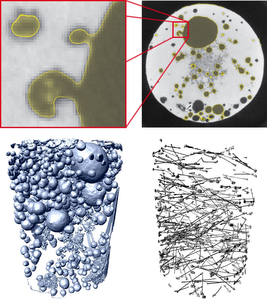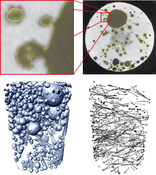Information
- Publication Type: Master Thesis
- Workgroup(s)/Project(s):
- Date: October 2011
- First Supervisor:
- Eduard Gröller
- Markus Hadwiger
- Laura Fritz
- Eduard Gröller
Abstract
Non–destructive testing (NDT) is a vital part in today’s industrial production and research processes. Such testing procedures often use Computed Tomography (CT) in order to get insights of the inner parts of an object. During the analysis of different objects, certain features can be automatically segmented and quantified in the CT dataset. However, due to various effects during the acquisition of the data, the original boundaries of two materials within the objects are not accurately represented in the dataset. This thesis describes a method to reconstruct these boundaries for automatically segmented features on a subvoxel level of the dataset. They are searched along the gradient of the data, using an edge–detection approach commonly used in image processing. The result is then represented as a distance field and further quantified through over–sampling and measuring. For a variety of datasets it is shown that these reconstructed boundaries are indeed providing a more accurate representation of the original segmented region. Further comparisons are made with a method that simply tries to improve the visual appearance through smoothing.Additional Files and Images
Weblinks
No further information available.BibTeX
@mastersthesis{Gschwantner_2011_AMQ,
title = "Advanced Measurement and Quantification of Industrial CT
Data",
author = "Fritz-Michael Gschwantner",
year = "2011",
abstract = "Non–destructive testing (NDT) is a vital part in today’s
industrial production and research processes. Such testing
procedures often use Computed Tomography (CT) in order to
get insights of the inner parts of an object. During the
analysis of different objects, certain features can be
automatically segmented and quantified in the CT dataset.
However, due to various effects during the acquisition of
the data, the original boundaries of two materials within
the objects are not accurately represented in the dataset.
This thesis describes a method to reconstruct these
boundaries for automatically segmented features on a
subvoxel level of the dataset. They are searched along the
gradient of the data, using an edge–detection approach
commonly used in image processing. The result is then
represented as a distance field and further quantified
through over–sampling and measuring. For a variety of
datasets it is shown that these reconstructed boundaries are
indeed providing a more accurate representation of the
original segmented region. Further comparisons are made with
a method that simply tries to improve the visual appearance
through smoothing.",
month = oct,
address = "Favoritenstrasse 9-11/E193-02, A-1040 Vienna, Austria",
school = "Institute of Computer Graphics and Algorithms, Vienna
University of Technology ",
URL = "https://www.cg.tuwien.ac.at/research/publications/2011/Gschwantner_2011_AMQ/",
}

 Thesis
Thesis

